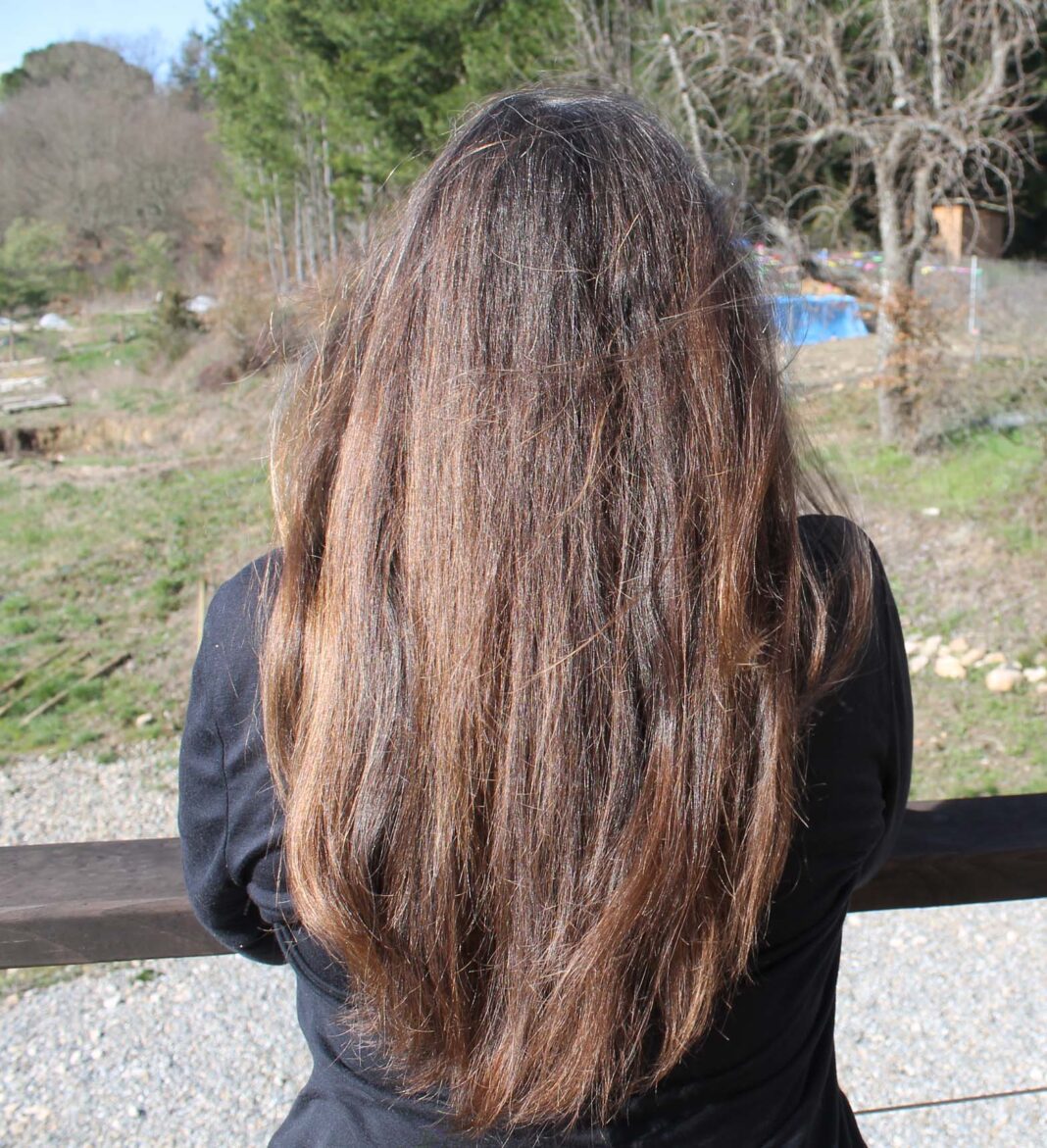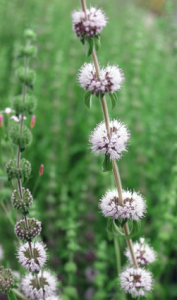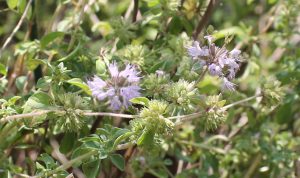Pennyroyal: Sekhmet’s Gift
Pennyroyal: facts and folklore
Pennyroyal, Mentha Pulegium, has a killer reputation. In relatively recent times, several women have died using pennyroyal to end unwanted pregnancies. One was a 23 year old English woman in 1897, who drank a tablespoon of pennyroyal essential oil to bring on menstruation and died four days later of multiple organ failure. In 1912, a 16 year-old girl from Maryland died after consuming 36 pennyroyal pills to induce abortion. In November of 1978, there were two cases of pennyroyal poisoning within four days at Denver General Hospital. The first was an 18 year-old woman, who drank an ounce of pennyroyal essential oil and died seven days later, not pregnant. In the second Denver case, a young woman took 10ml of pennyroyal essential oil (a little less than a tablespoon) and was discharged after two days, still pregnant. In 1994 a 24-year-old woman, died in California after drinking pennyroyal tea. At the time of her death, she unknowingly had an ectopic pregnancy and the autopsy was unable to confirm whether her death was as the result of the ectopic pregnancy or from pennyroyal poisoning.
How did these women find out about pennyroyal’s reputation as means of inducing a miscarriage? Is this ancient wisdom enshrined in phylogenetic memory? Or does pennyroyal have other abilities, perhaps involved in ‘switching on’ (or off maybe) certain memory files?
Most of the internet references to pennyroyal’s effectiveness as an abortifacient or emmanegogue come from the same sources. This is from Wikipedia and you’ll find it repeated word-for-word on multiple sites:
“Documented use of pennyroyal dates back to ancient Greek, Roman, and Medieval cultures. Its name – although of uncertain etymology – is associated with Latin pulex (flea), alluding to the manner it was used to drive away fleas when smeared on the body.[5] Pennyroyal was commonly incorporated as a cooking herb by the Greeks and Romans. A large number of the recipes in the Roman cookbook of Apicius called for the use of pennyroyal, often along with such herbs as lovage, oregano and coriander. Although it was commonly used for cooking also in the Middle Ages, it gradually fell out of use as a culinary herb and is seldom used as such today.[6]
Records from Greek and Roman physicians and scholars contain information pertaining to pennyroyal’s medicinal properties, as well as recipes used to prepared it. Pliny the Elder, in his encyclopedia Naturalis Historia (Natural History), described the plant as an emmenagogue, and that it also expelled a dead fetus.[7] Galen only listed pennyroyal as an emmenagogue, as did Oribasius. Roman and Greek writers Quintus Serenus Sammonicus and Aspasia however both agreed that pennyroyal, when served in tepid water, was an effective abortive method.[7] A medical text on gynecologyattributed to Cleopatra (though it was never written by her but by a female Greek physician Metrodora) recommends the use of pennyroyal with wine to induce abortions.[7]
In regard to its contraceptive properties, it was referred to in a joking manner in Aristophanes‘ play Peace (421 BCE). The god Hermes provides the male character Trygaios a female companion; when Trygaios asks if there would be a problem if she became pregnant, Hermes responds, “Not if you add a dose of pennyroyal.”[5]In a similar manner, in Aristophanes’ comedy Lysistrata, after a pregnant female character on stage is told to withhold her body sexually from her husband, a slender female character, in comparison to the pregnant woman, is described as “a very lovely land. Well croppy, and trimmed and spruced with pennyroyal.”
Pliny the Elder also stated that consuming powdered sow’s dung relieved labour pains. Not everything written in ancient times is true, or workable today. I haven’t found any evidence to support the notion that pennyroyal works as a contraceptive, but it should not be used in pregnancy as it does increase the risk of miscarriage. Many herbalists will confirm that it is reliable for period pain and related issues.
There are some reports that pennyroyal was an ingredient in kykeon, the psychoactive potion given to the initiates in the Eleusinian mysteries. It is still burned in South America as a ritual offering to Pachamama and is said to have magical powers of protection, or to bring prosperity.
According to Hildegard von Bingen, in her work Physica, written between 1150 and 1158:
“He who has pains in the brain so that he is ill should add pennyroyal to wine and boil it, and he should lay it on his head while still warm, and he should tie a cloth over this, so that the brain is warm and suppresses the madness in him.”
The little clumps of pennyroyal growing around here grab you by the nose as you walk by and spike your mind, triggering memories which might not even be your own. You can’t come close to getting a feel for how she works through scientific explanations, but I find that this excerpt from In The Country of the Pointed Firs, by Sarah Orne Jewett, (1910) leads you in the right direction:
Pennyroyal, like beads on a string“When the family pictures were wrapped again in a big handkerchief, we set forward in a narrow footpath and made our way to a lonely place that faced northward, where there was more pasturage and fewer bushes, and we went down to the edge of short grass above some rocky cliffs where the deep sea broke with a great noise, though the wind was down and the water looked quiet a little way from shore. Among the grass grew such pennyroyal as the rest of the world could not provide. There was a fine fragrance in the air as we gathered it sprig by sprig and stepped along carefully, and Mrs. Todd pressed her aromatic nosegay between her hands and offered it to me again and again.
“There ‘s nothin’ like it,” she said; “oh no, there ‘s no such pennyr’yal as this in the State of Maine. It’s the right pattern of the plant, and all the rest I ever see is but an imitation. Don’t it do you good?” And I answered with enthusiasm.
“There, dear, I never showed nobody else but mother where to find this place; ‘t is kind of sainted to me. Nathan, my husband, an’ I used to love this place when we was courtin’, and”—she hesitated, and then spoke softly—”when he was lost, ‘t was just off shore tryin’ to get in by the short channel out there between Squaw Islands, right in sight o’ this headland where we ‘d set an’ made our plans all summer long.”
I had never heard her speak of her husband before, but I felt that we were friends now since she had brought me to this place.
“‘T was but a dream with us,” Mrs. Todd said. “I knew it when he was gone. I knew it”—and she whispered as if she were at confession—”I knew it afore he started to go to sea. My heart was gone out o’ my keepin’ before I ever saw Nathan; but he loved me well, and he made me real happy, and he died before he ever knew what he ‘d had to know if we ‘d lived long together. ‘T is very strange about love. No, Nathan never found out, but my heart was troubled when I knew him first. There ‘s more women likes to be loved than there is of those that loves. I spent some happy hours right here. I always liked Nathan, and he never knew. But this pennyr’yal always reminded me, as I ‘d sit and gather it and hear him talkin’—it always would remind me of—the other one.”
Pennyroyal the healer
I’d been getting to know pennyroyal for a year or so, when some friends asked if I could help their cat. I’m not a trained herbalist, nor any kind of medical or veterinary professional, but when a friend asks for help I’ll do the best I can. Mostly, it has worked out well for all concerned, there is always a risk. The cat had a weak immune system, was probably in the early stages of kidney disease and had acute scabies that wasn’t responding to treatment. After careful research and discussing the risks and options, I gave the owners some of my own pennyroyal herbal oil for the scabies, as it is the fastest way of killing the mites, through contact with the active ingredient in the plant and through suffocation through the oil. A few days after the treatment, they reported back that the cat was much improved and was hunting again. I don’t know what happened in the interim but, a couple of months later, tragedy struck and the cat died unexpectedly of kidney failure.
Nothing was said at the time, but I did consider the possibility that I’d made a fatal error and I went back to research everything I could find on pennyroyal for cats. The consensus is pretty clear, pennyroyal ESSENTIAL OIL is highly toxic for cats and should never be given to them, but there’s no information about the herbal oil. I couldn’t find any instances of a cat ever having been poisoned by pennyroyal essential oil either, but then, how would you know? Most often, you find information ‘copied and pasted’ from one site to another, without it ever having been verified by a single one of them.
The effectiveness of all plants and herbs will vary according to the strain, where they grew, what time of the day or the month they were harvested and how they were stored and prepared. Therein lies the appeal of the standardised approach of systemised medicine and pharmaceuticals but, of course, life stubbornly refuses to comply. Every creature has their unique experience and circumstances and they will respond better to some plants rather than others and the decision as to what to use, what dose, how and when, can only be made on an individual case by case basis. The terrible truth, that every healer knows, is that, not only will you make mistakes, but you can also do everything correctly and still not get the desired outcome – fate is always waiting in the shadows and there are always those that you cannot work with. When the choice is between third party information or my own instincts, I have to follow my guidance and face the consequences.
That said, there is a HUGE difference between pennyroyal essential oil and pennyroyal herbal oil. I make herbal oil, or sun oil, is made by steeping the leaves and flowers of the plant in olive oil and leaving it in the sun for several weeks, so that the plant oils leech into the olive oil. I then discard the plant material and use the infused oil topically. Herbal oil is generally considered to be safe as it is nowhere near as concentrated as the essential oil. Essential oil, the kind you buy in small bottles, is made through an industrial process by pressure steaming the plant material and cooling the vapour so that the essence of the plant in the form of its oil separates from the water. (The water is sometimes sold as a floral water or hydrosol.) Essential oil can be hundreds or even thousands of times more potent than the plant in its natural form and the smaller molecules are more easily absorbed by the skin. The real danger to humans and other animals is from consuming pennyroyal essential oil, a standard 12ml bottle could be fatal. You would have to be pretty desperate to drink a bottle of essential oil. This can be an issue for animals, who will lick and groom themselves and I’d never use any essential oil on a cat. I wouldn’t use pennyroyal essential oil for any reason, but then the plant grows wild here.
Ancient alchemists are also said to gave used steam distillation as one method of releasing the essence of the plant – the plant spirit. However, what we are able to glean from surviving alchemical texts is a mere shadow of what would have been known before the intervention of Christianity. And today, the principles of alchemy can only be considered and tested in a very different time and context. I look at the alchemical images and I see that the oft depicted flask is the human body and the principles of mercury and sulphur are the yin and yang or the ida and pingala, the quintessence is intention. This perspective has crystallized as I’ve used pennyroyal, whose spirit is activated by human intention – to kill or to heal.
Pennyroyal herbal oil has become one of our regular home remedies for ourselves and the dogs. We use it by rubbing a little over the solar plexus area or lower abdomen and it has an immediate calming effect with an accompanying feeling of relaxed self-confidence. It helps Freya get through her frantic moments and seems to make it easy for Tulku and Izzy to give her the space to do that without reacting to her shenanigans. Freya, as a spayed, vaccinated dobermann with a docked tail (she’s a rescue dog), has the occasional urinary incontinence issues and pennyroyal herbal oil rubbed on her lower abdomen helps her with that too. It works instantly. I find it gives me mental clarity and a more balanced perspective on events and experiences. Often just sniffing it is sufficient, as the olfactory bulb is part of the central nervous system. We also drink the leaves as a digestive tea, which has a light, refreshing flavour, similar to mint, but more floral.
Prior to industrial processing, pennyroyal was considered an essential healing herb to have at home:
“This plant, which the God of nature has scattered over almost every part of this country, is one of the most valuable of the Thomsonian Materia Medica. Its qualities are a strong and hardy aromatic but pleasant smell, a warm and pungent taste. The medical principle resides in an essential oil, possessing the same smell and taste of the herb. Its medical properties are carminative, (having power to remove wind from the stomach and bowels,) stimulant, (possessing the property of exciting increased action in the system,) diaphoretic, (promoting moderate perspiration. ) It also relieves spasms, hysterics, promotes expectoration in consumptive coughs, and is a good medicine in the whooping cough. It is good also to take away marks and bruises in the face, being bruised in vinegar, and applied in fomentations.
A tea of this plant is perhaps the best drink that can be given, together with the composition powder, Cayenne, etc., to warm the stomach, and assist an emetic in its operations. The tea should be made and given warm, freely and frequently. A person upon taking a “bad cold,” (by the way, he never has a good one,) by taking freely of this tea may throw it off, and of course prevent fever, it being caused by cold. This is a popular remedy all over the country for female complaints; but still few persons are aware of its extensive medicinal properties.
The best time for gathering this herb is about the month of August. It should be tied up in bundles, and hung in a warm, dry, and shady place until dry; then wrapped in paper, as the best means of excluding the air, by which, if exposed, it will lose a large part of its strength and virtue. This plant, simple as it is, will do more in the curing of the sick than all the poisonous preparations invented since the age of Paracelsus; bleeding and blistering into the bargain. No family should let the season for gathering it pass without securing a good supply.”
A Guide to Health, Benjamin Colby, 1846
One of my ‘go to’ references for plant remedies is, The Energetics of Western Herbs: A Materia Medica Integrating Western and Chinese Herbal Therapeutics by Peter Holmes. Traditional Chinese Medicine and alchemy spring from the same root and are mostly concerned with the transformative effects of the movement of qi, through the cosmos, the earth and the body. You can’t perceive qi with your ordinary senses, but it leaves its footprint in the imagination – TCM practitioners are trained to ‘feel’ the movement of qi in the pulse for diagnostic purposes. In the broadest sense, imagination itself could be said to be the product of qi, which is the driver of what is called the placebo effect – your innate ability to heal yourself. Western medicine focuses on biological mechanics (the shen of TCM), with barely a nod to the psyche and no recognition at all of any interactions with the natural and supernatural worlds. But it has provided a great deal of validated scientific information regarding the cellular activity of plants and other organisms. If alchemical regeneration is to be found anywhere, it will be in the sweet-spot where these two approaches converge. I work with the wild plants around here, not just for their therapeutic effects, but because of how they work on my imagination. I like this book as it’s comprehensive and considers western plants from a TCM perspective.
This is part of what it has to say about pennyroyal:
“Caution: Being a uterine stimulant with mild neurotoxicity, Pennyroyal herb is contraindicated during pregnancy. Do not use this herb continuously (unlikely) at maximum doses because of its medium strength status.
The essential oil of Pennyroyal, which is extracted from both European and American types of pennyroyal, is contraindicated for internal use. It contains high levels of the ketone pulegone, which is neurotoxic. Note that American Pennyroyal (Hedeoma) has a higher content of pulegone than the European variety, and seems more spasmolytic on the sommoth muscles than its European counterpart.
NOTES
Pennyroyal herb refers to the European and the two North American genera of pennyroyal. While Mentha pulegium is the botanical sourse of European pennyroyal, various Hedoema and Monardella species are the sources of American pennyroyal. The nature, functions and uses of all these are virtually identical.
Pennyroyal herb is a reliable woman’s remedy that particularly excels in menstrual and childbirth situations when events become painful, delayed and difficult. Like Blue cohosh root, the herb is both actively uterine stimulant and relaxant, and so appropriate for both weak and tense types of conditions. As a stimulant emmenagogue, Pennyroyal treats functional amenorrhea; as a spasmolytic, it treats spasmodic dysmenorrhea; both conditions are seen in the syndrome uterus Qi stagnation with constraint. “It is an antispasmodic nervine and will be found valuable in dysmennorrhea in nervous ladies, and is of good service in hysteria” (LYLE 1897). “Hysteria” today would be described as PMS.
Pungent, bitter and aromatic in quality, Pennyroyal herb is also a stimulant to digestive and respiratory functions. It acts as an excellent cholagogue, aperitive and relaxant in treating upper digestive stagnation and will improve the appetite. In children, Catnip or Fieldmint would be complementary herbs. In the syndrome lung phlegm-cold-damp, the herb is a good mucolytic expectorant for chronic forms of bronchitis and asthma.
Similar to Vervain herb, when drunk hot Pennyroyal herb is a vasodilatant diaphoretic and will cause sweating and dispel wind-heat colds and flus. It will also promote the appearance of eruptions in eruptive fevers.
In the words of MAUD GRIEVE (1931): “Pennyroyal is often found in cottage gardens, as an infusion of the leaves, known as Pennyroyal Tea, is an old-fashioned remedy for colds and menstrual derangements.” It was often combined with Mugwort herb for both these conditions.
In North African countries such as Morocco, European pennyroyal has been given for untold years for heatstroke. Where heatstroke or fever threatened to cause spasms or seizures – signs of internal wind – Pennyroyal is still the right remedy. A sweetened infusion of the herb would be a useful preventive of children’s spasms or convulsions, for example. Here, like Melissa leaf of Lavender flower, Pennyroyal can act as gentler, milder version of Lobelia herb or Yellow jessamine root (Gelsemium).”
As I began writing this post, after an interlude of nearly two years, the owners of the cat who passed away decided to inform me of my negligence in giving them pennyroyal essential oil for their cat, which I hadn’t done. Uncomfortable though that was, what stopped me dead in my tracks was that, the night before ‘the accusation’ I dreamed about it happening in exquisite detail. I had the strange, intense, trance-like feeling that I’ve experienced on many occasions in my life, that I’m beginning to think of as a pull from the future. Pennyroyal was reaching into my dreams, making connections in my brain and I felt that I was being guided. Clearly, pennyroyal had more to tell.
The dose makes the poison, Paracelsus
Pulegone: insecticide and archonticide
The primary active ingredient in pennyroyal is pulegone. Pulegone is a type of terpene. Terpenes are organic plant compounds that give them each their distinctive smell, through various combinations in each type of plant. Pennyroyal contains a dozen or so terpenes in all, which are also found in other plants. For example, rosemary has a high terpinene content, which gives turpentine its signatory smell and is also found in different amounts in apple, cumin, lilac and tea tree. Rosemary contains more terpinene than pulegone, but it is pulegone that gives rosemary its memory enhancing capabilities. The art and science of perfume making is all about terpenes.
Pennyroyal aka fleabane, or flea mint, (from Mentha Pulegium, deriving from the latin pulex, meaning flea) is a member of the Lamiaceae family of herbs, commonly known as the mint family. It was originally called the Labiatae family, because the flowers have petals fused into an upper and lower lip – how very rude! Other members of this family are: thyme, mint, oregano, basil, sage, savory, rosemary, self-heal, hyssop lemon balm and catnip. The main terpenes in catnip, Nepeta cataria, are nepetalactone and pulegone, with a higher concentration of nepetalactone than pulegone – catnip is safe for cats. Pennyroyal has the highest concentration of pulegone in the Lamiaceae family, which makes it harmful in large amounts.
In nature, pulegone protects the plant, and other plants in the immediate vicinity, from being eaten by insects. Plants from the Lamiaceae family can help keep bugs away from windows, doorways and outdoor seating areas. Clearly, it is one reason why pennyroyal is also known as fleabane. It is sometimes used in flea collars for cats and dogs, but these can be toxic too. Just because something is natural doesn’t mean that it’s safe, especially if you don’t know the amounts and combinations of other ingredients.
Pulegone has been quite well-studied because of its nootropic potential. The human brain’s most abundant neurotransmitter is acetylcholine, which assists in carrying signals across the nerve synapses and is essential for muscle stimulation, sleep regulation, memory formation, mental health and protecting the brain from neurological decay. Acetycholine is produced in short bursts throughout the brain, the central nervous system and the peripheral nervous system and is almost immediate broken down into acetic acid and choline by the enzyme acetylcholinesterase. Pulegone is an acetylcholinesterase inhibitor, meaning that it prevents acetylcholinesterase from destroying acetycholine, so that more of it is available to be used by the brain and nervous system. Acetycholinesterase inhibitors are considered beneficial for Alzheimers and other forms of cognitive impairment. However, pulegone doesn’t have star quality as a pharmaceutical, because of its toxicity when consumed and because of a special quality that doesn’t allow it to be reliably synthesized. That quality is its chirality.
In chemical terms, terpene molecules are described as enantiomers, which are simple types of optical isomers. This refers to their ability to spin plane polarised light in either a clockwise or an anti-clockwise direction. When you see chemical references to pulegone, the clockwise direction is denoted by (+) and the anti-clockwise direction (-). The chemical structure of (-) and (+) molecules are the same, but the arrangement is different, so that each molecule is unique – in much the same way as your hands are of the same structure, but mirror each other in such as way that one cannot ever be a substitute for the other. In naturally occurring pulegone, there will be a mix of (-) and (+) molecules that cannot be replicated in a laboratory. The laboratory product will always have equal (-) and (+) molecules and can never reproduce the biochemical, or its effects, as it works in nature.
So, what does all this mean? My direct experience is that pennyroyal/pulegone has the dual effect of enhancing some cognitive and memory based functions and filtering out others. It does this biochemically and electromagnetically/optically, through the combination of acetylcholinesterase inhibition and biophoton modulation – in simple terms, it recalibrates the blinkers! All mammalian brains produce biophotons and scientists are currently exploring the possibilities that the brain might have optical communication channels, although they apparently have no idea what could be communicated!
Polarized light navigation is used by bats, bees and other insects to forage and find their way home. The mantis shrimp communicates with other shrimp through polarized light signaling, that is invisible to other creatures. Aphids can see the different polarization patterns in infected plants and are attracted to them as diseased plants have a diminished ability to raise any biochemical defense. Pulegone spins light in such a way as to have an antifeedant action on the aphids, which is what makes it such an effective insecticide and, in accordance with the principle of correspondence, it works in the same way with the mind parasite.
I found that applying pennyroyal herbal oil on my skin, or just sniffing it, made it easier to see when I was going into self-doubt or mental looping, worrying over what might happen, or over analysing past actions and to replace that destructive pattern with creative thoughts and actions. In other words, using the power of my imagination to create what I don’t want, rather than using it correctly and intentionally. Pennyroyal herbal oil helps me clarify and focus my attention, so that I can see the ‘infected’ pathway that is ‘not me’ and choose to ‘not feed’ that self-destructive pattern. The mind parasite’s primary weapon is its invisibility – it has no defenses and no materiality of its own. It can only exist by co-opting your neurophysiology and once you recognize its pathology, in that split-second when you choose a different path, it’s game over. And that is the ‘archonticidal effect’ of pulegone. Once you see it in yourself, you can also see how it operates as a self-destructive process in others and how it recruits them into becoming unwitting agents of the enemies of life – more on that in a later post.
Pennyroyal Protection
Sekhmet gives us pennyroyal, at her best in the fierce August sun, imbued with Her ability to kill or to heal, Her great affinity for women’s issues and a particular relationship with cats. Pennyroyal works especially well with the solar plexus to bring courage to will.
A curious fact about pulegone is that it prevents corrosion of steel. (Effect of pulegone and pulegone oxide on the corrosion of steel. Steel is mostly iron and carbon, so it’s not much of a metaphysical hop to consider that pulegone might also protect the individual will from the corrosive effects of a sick society. If might be fanciful, but I have the distinct impression that pennyroyal can ‘abort’ the false self, which can be risky if that’s all you have.
Pennyroyal Tea, Nirvana, 1993
I’m on my time with everyone
I have very bad posture
Sit and drink Pennyroyal Tea
Distill the life that’s inside of me
Sit and drink Pennyroyal Tea
I’m anemic royalty
Give me a Leonard Cohen afterworld
So I can sigh eternally
I’m so tired and I can’t sleep
I’m anemic royalty
I’m a liar and a thief
I’m anemic royalty
I’m on warm milk and laxatives
Cherry-flavored antacids
Sit and drink Pennyroyal Tea
Distill the life that’s inside of me
I’m anemic royalty
I’m anemic royalty
The Heart of Co-creation
Salvage Greenhouse
You May Also Like
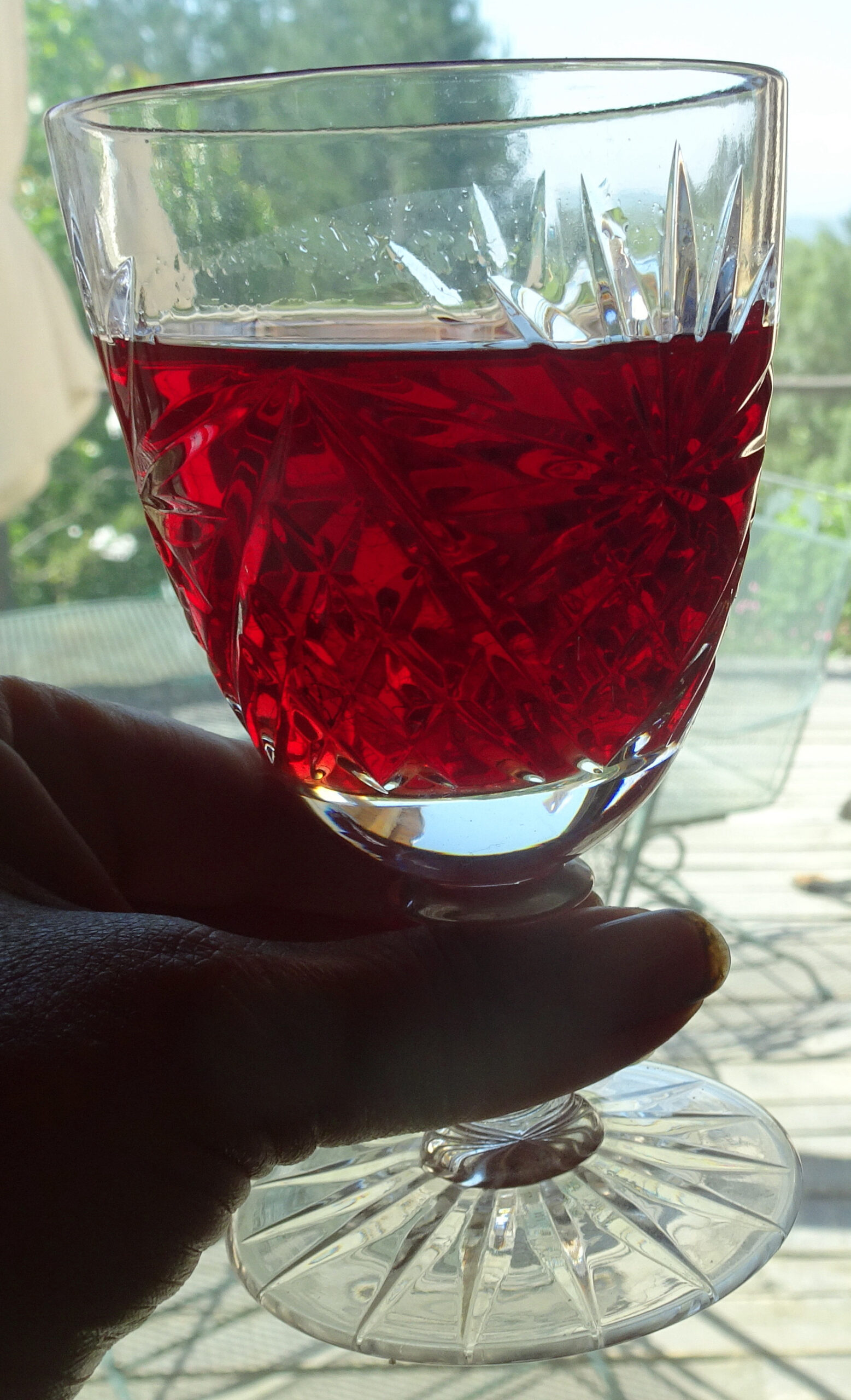
St John’s Wort: Blood from the Sun
August 4, 2021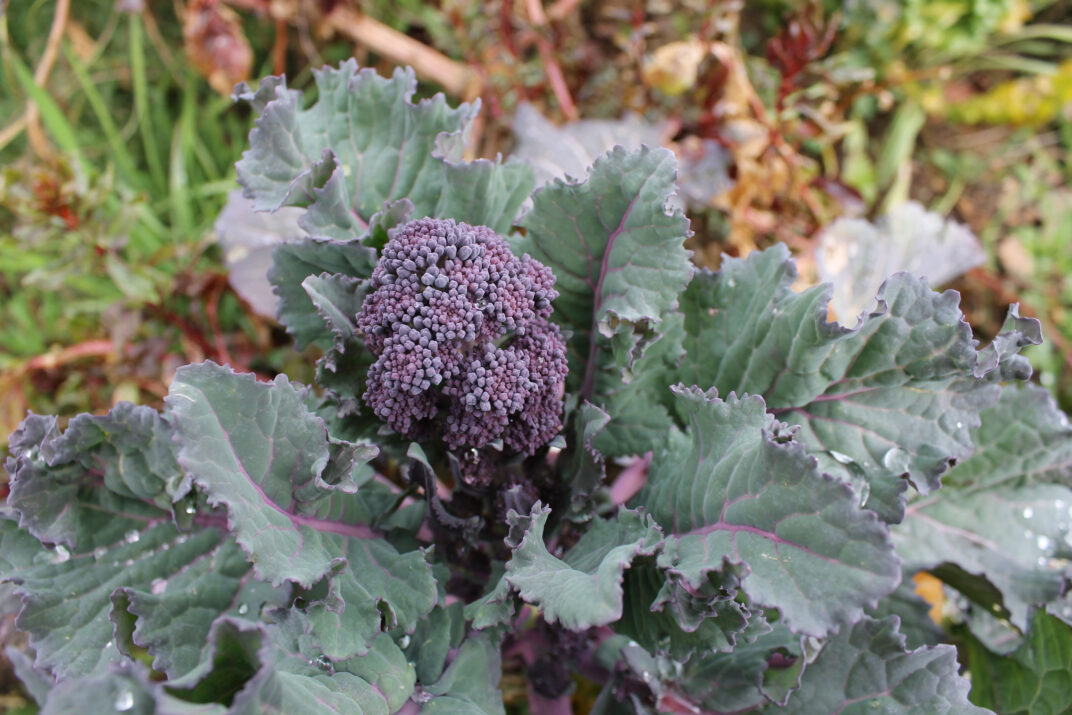
Broccoli Medicine
March 8, 2020